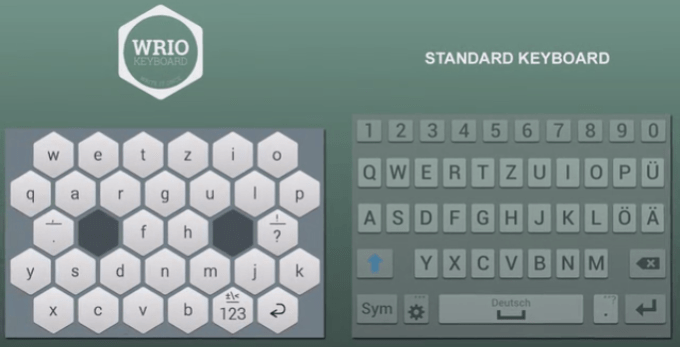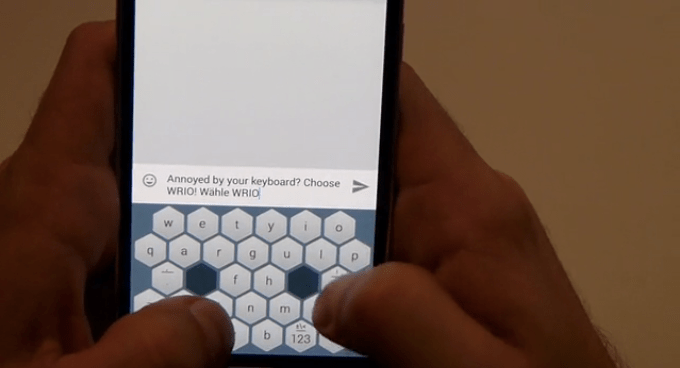Another keyboard contender is taking aim at the touchscreen typing experience. Meet Wrio, a keyboard-in-development that changes the shape of the keys from squares to honeycomb-style hexagons in a bid to make keys a more finger-friendly shape and squeeze out typos.
The bootstrapping Swiss duo behind the concept have just kicked off a crowdfunding campaign, on Kickstarter, aiming to raise just over $10,000 (Fr 10,000) to finish dev work for what will initially be an Android keyboard. If that flies, their next move would be to address iOS.
At this stage they have an alpha release but need the crowdfunding to finance additional features such as a dynamic layout for correcting imprecise typing behavior and auto completion with support for multiple languages.
The fiddliness of typing on touchscreens makes the keyboard a irresistible target for startups itching to fix problems. Developers have attacked keyboards from all angles, whether it’s ambitious attempts to reboot the traditional Qwerty letter order, fancy AI to enhance next word prediction, applying different input methods such as gestures to speed the typing mechanic, squeezing the size of the keyboard so it takes up less screen space, or focusing on richer media like GIFs or emoji to spice things up.
There’s certainly no shortage of choice for alternative keyboards on Android or iOS — perhaps because no one alternative has been so successful as to kill off all the others. Which also means alt keyboards — like Wrio — will keep on coming.
As well as finger-friendly honeycomb-shaped keys, Wrio’s keyboard as a few other neat tricks up its sleeve: a thumb-optimized layout, with two space keys (one for each thumb) which also double as a switch for other keyboard layouts (such as special characters); gestures for faster deleting, shift switching and space; and a tweaked character layout that puts certain characters on the main level to speed up typing by reducing the need to switch keyboard layouts.
“We’ve placed all other important characters together with numbers, so that in 99% of the cases a user has to use maximum two layers, instead of three with current keyboards. (this was also a major complaint from our test group!),” they note.
The main complaint of the 150-strong test group was that keys were hard to hit — and it was that feedback that ultimately led them to their honeycomb key design.

The design certainly appears to yield more spacious keys, but it’s worth noting it does slightly tweak the Qwerty layout, so will probably still require a little bit of a learning curve to get to grips with. (And that learning curve in large part explains why the plain old standard Qwerty keyboard has so tenaciously stuck with us, ever since the days of mechanical typewriters.)
Autocorrect support for multiple languages does sound like a very handy feature — certainly for certain European countries, and particular demographics in the U.S.
“In Switzerland, we speak three languages plus English. Also in the US, there are a lot of people that also speak Spanish or Portuguese, and currently it’s simply a pain to switch keyboards. Our goal is to unify at least the main Western languages (English, Spanish/Portuguese, French, German) into one layout, without having any disadvantages for the English-only typers (which is our main target group),” they note. “Chinese would then be the next challenge.”
If they can hit their Kickstarter funding goal, they’re aiming to ship a beta in November and deliver the final keyboard software by March. At this stage they’re not settled on a business model. One option is to make the final keyboard a paid app, or else they may offer in-app purchases for certain features.
“We haven’t reached a conclusive answer yet. From our 150 test group it follows that many people would be willing to pay for a good keyboard app… I think using our kickstarter community will be a great way of asking what people want,” they add.
